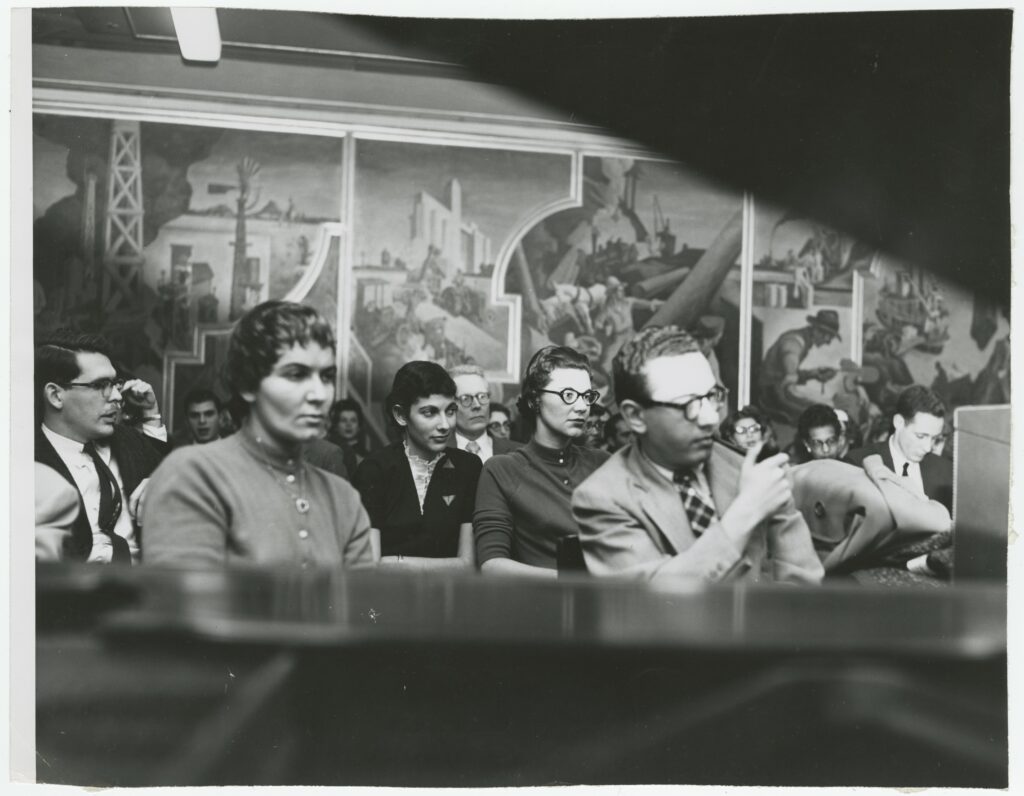From the Walls of The New School to The MET: Revisiting Thomas Hart Benton’s America Today
by Vicky Oliver, Nonfiction Editor

Thomas Hart Benton’s ten-panel mural, painted with egg tempera and oil glazing over Permalba on a gesso ground linen mounted to wood panels with a honeycomb interior. Originally painted in 1930-1931 for the New School, America Today now resides at the MET.
At the New School, we write stories. Whether we are setting down our pasts or conjuring a future world or are just trying to capture what is happening right now in the present, we tend to see narrative structures unfolding all around us. Each day, a blank piece of paper calls to us, summoning us to take a leap of faith, and create.
But what about a blank wall?
The interior, now-blank walls of the old New School Board Room on the third floor of 66 West 12th Street once told a story of a country captivated with the new technology of the time. It was a story of progress, as illustrated by trains racing across the country, ships cruising the waterways, subways transporting people to their offices, factories manufacturing goods, and airplanes flying celestial blue skies. A story of forward motion, of resilience, of a can-do-American work ethic. A recent trip to the Metropolitan Museum of Art helped me become aware of this story, which began many decades ago during the Great Depression and still has relevance today as we also look to an uncertain future and confront new technologies.
In 1930, then-president of The New School Alvin Johnson, commissioned artist Thomas Hart Benton to paint some murals for a new construction on 12th Street designed by Joseph Urban that responded to The New School’s increase in enrollment and expansion of classes.
“I’ll paint you a picture in tempura,” Benton famously replied, “if you’ll finance the eggs.”
Installed on each wall of the boardroom on the third floor was a panel from America Today, and “the new building” at 66 West 12th Street was opened to the public in 1931.
The rest of this exuberant 10-panel mural that now resides in its own room at the Metropolitan Museum of Art is history. Even if some of the individual portraits in the piece feel a bit dated, the vibrancy and emotion of the piece shines through. I ended up visiting the mural several times, the first time to simply take in its splendor, the second and third times to try to capture it in a series of photos. After my fourth visit, I wanted to see what the murals looked like when they hung on the walls of The New School so I contacted the friendly folks at The New School Archives & Special Collections. The result is below.
As it turns out, a blank wall can have a pretty storied past.

The boardroom was later turned into a classroom. Pictured above are the students in Marshall Stearns’s “The Role of Jazz in American Culture” course in spring of 1958. The walls behind them feature the Benton murals.

In 1956 and again in 1968 Thomas Hart Benton returned to restore the murals. The New School’s student body had grown so much during the post-WWII boom that the murals began to show wear from the increase in traffic to the classroom.

Bob Adelman, a photographer who captured the Civil Rights era, visited The New School around 1979 to document a class in session. Behind the students, Benton’s creations are hard at work.
By 1982 the New School recognized that expensive restoration and conservation efforts would need to be perpetual to care for the murals. After living for over half a century at the New School, America Today was sold to the Maurice Segoura Gallery with the condition that it would never be resold outside the U.S. or as individual panels. Then New York City Mayor, Ed Koch, lobbied to keep America Today in New York City.
Acquired by Equitable Life in 1984 (now AXA), Benton’s masterpiece was donated to the Metropolitan Museum of Art in 2012, where it now resides in its permanent collection in its own gallery the walls of which reflect the original configuration of the board room at 66 West 12th Street.

A foreshadow to The WPA in public arts projects, America Today is considered one of the most significant accomplishments of American art during the interwar period.




